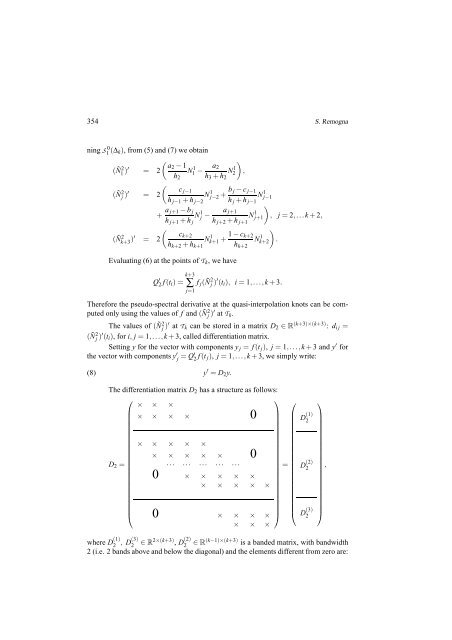Pseudo-spectral derivative of quadratic quasi-interpolant splines
Pseudo-spectral derivative of quadratic quasi-interpolant splines
Pseudo-spectral derivative of quadratic quasi-interpolant splines
You also want an ePaper? Increase the reach of your titles
YUMPU automatically turns print PDFs into web optimized ePapers that Google loves.
354 S. Remogna<br />
ningS1 0(∆ k), from (5) and (7) we obtain<br />
(<br />
(Ñ1 2 a2 − 1<br />
)′ = 2<br />
(<br />
(Ñ 2 j )′ = 2<br />
h 2<br />
N 1 1 − a 2<br />
h 3 + h 2<br />
N 1 2<br />
+ a j+1− b j<br />
N 1 j −<br />
h j+1 + h j<br />
(<br />
(Ñk+3 2 )′ = 2<br />
)<br />
,<br />
c j−1<br />
h j−1 + h j−2<br />
N 1 j−2+ b j− c j−1<br />
h j + h j−1<br />
N 1 j−1<br />
a j+1<br />
h j+2 + h j+1<br />
N 1 j+1<br />
c k+2<br />
h k+2 + h k+1<br />
N 1 k+1 + 1−c k+2<br />
h k+2<br />
N 1 k+2<br />
Evaluating (6) at the points <strong>of</strong>T k , we have<br />
)<br />
, j = 2,...k+2,<br />
)<br />
.<br />
Q ′ k+3<br />
2 f(t i )= ∑ f j (Ñ 2 j) ′ (t i ), i=1,...,k+3.<br />
j=1<br />
Therefore the pseudo-<strong>spectral</strong> <strong>derivative</strong> at the <strong>quasi</strong>-interpolation knots can be computed<br />
only using the values <strong>of</strong> f and(Ñ 2 j )′ atT k .<br />
The values <strong>of</strong> (Ñ 2 j )′ atT k can be stored in a matrix D 2 ∈ R (k+3)×(k+3) : d i j =<br />
(Ñ 2 j )′ (t i ), for i, j = 1,...,k+3, called differentiation matrix.<br />
Setting y for the vector with components y j = f(t j ), j = 1,...,k+ 3 and y ′ for<br />
the vector with components y ′ j = Q′ 2 f(t j), j = 1,...,k+3, we simply write:<br />
(8) y ′ = D 2 y.<br />
The differentiation matrix D 2 has a structure as follows:<br />
⎛<br />
⎞<br />
× × ×<br />
⎛<br />
× × × × 0<br />
× × × × ×<br />
× × × × × 0<br />
D 2 =<br />
··· ··· ··· ··· ···<br />
=<br />
0 × × × × ×<br />
× × × × ×<br />
⎜<br />
⎟ ⎜<br />
⎝ 0 × × × × ⎠ ⎝<br />
× × ×<br />
D (1)<br />
2<br />
D (2)<br />
2<br />
D (3)<br />
2<br />
⎞<br />
,<br />
⎟<br />
⎠<br />
where D (1)<br />
2 , D(3) 2<br />
∈R 2×(k+3) , D (2)<br />
2<br />
∈R (k−1)×(k+3) is a banded matrix, with bandwidth<br />
2 (i.e. 2 bands above and below the diagonal) and the elements different from zero are:














